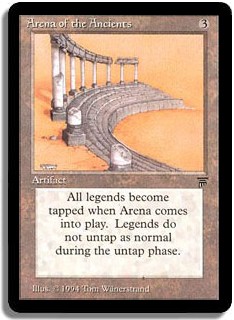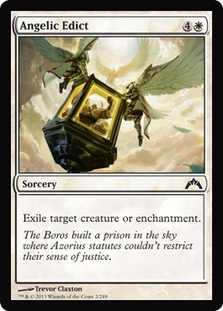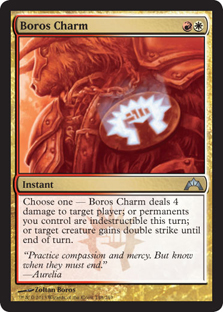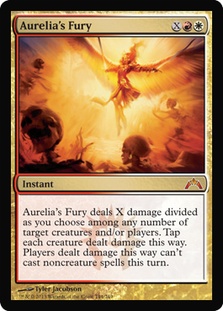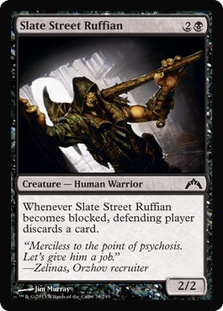Hello all and welcome back.
What did you do over the weekend? Chances are that many of you did the same thing as me: played in the largest Magic tournament in the history of the game. This past weekend, Grand Prix Charlotte drew 2,693 players for Gatecrash Limited.
After seventeen grueling rounds of Swiss (eleven Sealed Deck and six Draft), I finished with a respectable 13-4 record and a 44th place finish. Not too shabby, especially considering the fact that I needed to 3-0 my last draft pod to cash.
In today’s article, I am going to share some of the wisdom I’ve gained about Gatecrash Limited after having played it all weekend long.
Let’s start at the beginning:
The Grand Prix featured a SCG Gold Rush, where every player signed up for the event got a sealed envelope with cards from sets like Unlimited, Arabian Nights, and Legends. Unfortunately, I didn’t strike it rich:
“I was not an instant lottery winner.”
Sealed Deck
I didn’t crack a Mox or Black Lotus in the Gold Rush, but I was fortunate enough to open a playable Sealed pool.
Creatures (17)
- 2 Ember Beast
- 1 Viashino Shanktail
- 1 Gyre Sage
- 1 Truefire Paladin
- 1 Daring Skyjek
- 2 Knight of Obligation
- 1 Warmind Infantry
- 3 Disciple of the Old Ways
- 1 Rust Scarab
- 1 Scab-Clan Charger
- 1 Wasteland Viper
- 2 Wojek Halberdiers
Lands (3)
Spells (20)

The deck had some nice cards, but it also had a few problems. The biggest problem with the deck was that the mana was inconsistent. Luckily, I didn’t get punished for my mediocre mana nearly as often as I feared I would.
The pool that I opened didn’t provide me with any other options because I didn’t have enough playable cards to field a two-color deck of any combination. Since the only mana fixing in my pool were the three Naya lands and my best cards were mostly green and multi-Boros, I had little choice but to build the deck that I did.
Most of the time when I play Sealed, I simply go whatever way my mana fixing takes me. Remember, it doesn’t matter how good your spells are if you can’t cast them!
Ideally in an aggressive deck like this, I would play seventeen lands to avoid flooding in the mid and late game. The majority of my cards were two- and three-drops so I didn’t need a lot of land, just one of each color. I like to play eighteen lands in decks that have something to do with the extra lands when I draw them—for instance, a Looter creature or some Guildmages. I had a Truefire Paladin, but because green mana doesn’t pump him, it was difficult even when flooded to have the correct mana to pump him even twice!
Michael Jacob pointed out another interesting and counterintuitive problem with the way I built my deck. He suggested the two copies of Knight of Obligation were not very good in my deck. Knight of Obligation being bad took me by surprise since generally speaking the card is highly coveted in Draft. I have even first picked it while drafting. While Knight of Obligation may be an amazing card in grindy, defensive Orzhov decks, it was not a good fit for my Naya beatdown deck.
“So I swapped out this card I routinely first pick in Draft for this other card that rarely makes my Draft decks…”
Every single game after sideboard I made the following change:
+1 Angelic Edict
+1 Act of Treason
Both of these cards added unique, powerful, and desirable effects that made my deck more versatile.
It is also important to note that my deck had a lot of two-power creatures already. My big problem was punching through defenders with four toughness. For the investment of four mana, the Knights don’t really help do anything that I am weak against, which is why I sideboarded them out for cards that would help me.
The cards that really helped me with my weakness against Orzhov’s high toughness defensive creatures were the bloodrush cards. I have been really impressed with bloodrush in general. Being able to have a 2/2 punch through an opposing 2/4 or 4/4 is pretty amazing, especially because the spell can also be a creature if you need one.
However, one thing I want to point out is that people often bloodrush when they shouldn’t. I saw a lot of players making the same mistake where they attacked into an opposing creature and then bloodrushed to kill the blocker of the same size. In many cases, it is better to accept the trade and simply play the bloodrush creature. For instance, if you bloodrush pitching the 2/4 to save a 2/2 in combat, it might be better to simply let the 2/2 trade and cast the 2/4!
Also, simply trading instead of pumping is often a good idea if one suspects their opponent to have:
“Don’t get too smitten with bloodrush.”
The reason Smite is such an awesome card in this format is that it is the one common that really punishes an opponent for bloodrushing to pump their smaller attacker over your bigger blocker by creating a two for one and a lot of tempo for the Smiter. There is also not much the attacker can do about this situation besides not attack if an opponent has a Knight of Obligation and a white mana open.
The coolest play I made over the weekend was when I attacked my Knight of Obligation and Disciple into my opponent’s board of Kingpin’s Pet. He blocked my Knight and cast Smite on it, which I responded to by casting Boros Charm to make my guys indestructible, thus countering his Smite and then crushing his Pet in combat.
“Two for one-ing Smite all day long.”
One of the most important things I noticed about Gatecrash Sealed is that blue is by far the least popular color. Most of the decks I played against were either red decks (Boros, Gruul, or Naya) or Orzhov decks. There are some specific blue cards that are powerful enough to splash a strong Orzhov deck with good fixing into Esper (Consuming Aberration, Leyline Phantom, Agoraphobia, Stolen Identity, Soul Ransom etc.).
Both of the blue guilds, Simic and Dimir, have weaker mechanics that require a lot of synergies to make them powerful. In Sealed, it appears that it is the exception to get enough and the right cards for these color combinations to be consistently good.
Now, you may have looked at my list and said to yourself, “He’s got Aurelia’s Fury in his deck, so he must have just gotten a bunch of free wins.” The messed up thing is that in the eight rounds of Swiss I played with the deck, I only drew it one time! It did win that game pretty easily for me though. Although I didn’t get to cast the spell but once, I am aware that it is one of the best cards because in every game I lost, if I had drawn it I probably would have won.
With that being said, here are my Top 10 best cards for Gatecrash Sealed:
10. Assemble the Legion
9. Aurelia, the Warleader
8. Gideon, Champion of Justice (because it’s a planeswalker)
7. Domri Rade (because it’s a planeswalker)
6. Wrecking Ogre
5. Stolen Identity (on the list despite being blue!)
4. Rubblebelt Raiders
3. Obzedat, Ghost Council
2. Firemane Avenger
1. Aurelia’s Fury
“It does whatever you need it to, but mostly it deals A LOT of damage.”
Honorable mention goes to Master Biomancer, which would be on the list if Simic wasn’t nigh unplayable in Gatecrash Sealed. If you open your Sealed pool and think Simic is your best choice, it likely isn’t.
Back to my deck… Although it was pretty stingy about giving me Aurelia’s Fury off the top, the awkward mana only cost me one match where I got flooded and color screwed. It was to be expected, and I feel fortunate it only happened once in the entire tournament. My two Sealed losses were both to players who went on to make Top 8: Gerard Fabiano and Ben Stark.
Draft #1
My first draft was a train wreck.
Creatures (15)
- 1 Assault Griffin
- 1 Alms Beast
- 1 Duskmantle Guildmage
- 1 Crypt Ghast
- 1 Vizkopa Confessor
- 2 Syndic of Tithes
- 1 Duskmantle Seer
- 1 Court Street Denizen
- 1 Daring Skyjek
- 2 Dutiful Thrull
- 1 Gutter Skulk
- 1 Slate Street Ruffian
- 1 Dinrova Horror
Lands (7)
Spells (18)

I’d had quite a bit of success with drafting Esper thus far, so when I opened up a pack with Alms Beast I was pretty excited to try to jump right in. Unfortunately, after following that pick with Killing Glare, Syndicate, and Devour Flesh, I was unable to recognize that things were drying up fast.
My first pick was between Alms Beast, Killing Glare, and Slaughterhorn. I respect the logic of taking the green card and shipping the two black cards, but I felt that Alms Beast was better enough than the other cards to make it the pick. For those of you who haven’t played with Alms Beast, it is pretty insane because it’s so big that aggressive decks simply can’t attack into it.
Unfortunately, the reason that I got passed good BW commons was because the guy to my left was picking Orzhov rares, and my good cards quickly ran out.
“Scraping the very bottom of the barrel for playables.”
Gruul was wide open, and I missed the bus on it. I had a conversation with Mike about how and when to jump ship in this format, and his advice was to use the first three or four picks to try to spike the nuts and if it isn’t there to change colors. He said that the most important thing is to find what is available and draft it. Losing a few high picks isn’t that big of a deal because there are so many playable cards.
I ended up with six very good red and green cards in my sideboard that I scraped out of the bottom of some packs. (Two Ember Beast, one Disciple of the Old Ways, one Rust Scarab, one Skinbrand, and one Zhur-Taa Swine as a 12th pick). I wasn’t even trying and my Gruul deck was practically better than my Esper deck!
The problem with my deck was that while it had some nice cards, it didn’t have enough extort guys, it didn’t have creatures that could fight effectively, and it had a lot of difficulty closing out the game, even from ahead.
Orzhov is tricky because if you don’t have the high toughness guys, it is very easy for the red decks and Simic decks to run you over. A good rule of thumb for how to know Orzhov is getting cut in front of you is if you don’t see Basilica Screechers or Kingpin’s Pets in the first pack beyond the third pick. If picks four, five, and six don’t have the good, cheap extort guys, it is very likely that someone is gobbling them up ahead of you and that you might want to jump into another guild.
I ended up getting run over by a good Simic deck in the first round and then absolutely curb stomped by the guy who actually drafted the Gruul deck in the next round.
Derailed.
My hard fought 9-2 record and hopes for another Top 8 suddenly went out the window and became a struggle for survival because of a poor draft. Luckily, in the battle to not go winless in my pod, I got the upper hand against the other Orzhov drafter and narrowly edged out a win to stay alive.
Draft #2
The second draft went much better.
I began by taking the best card in the first pack, One Thousand Lashes, but quickly jumped aboard the Dimir train. I read the signal correctly that it was wide open because very strong cards were all tabling to me. Since I was able to table all of the Dimir Keyrunes and Dimir Guildgates, I also focused on taking very high quality white cards as a priority since I knew I would be able to splash them at little cost.
Creatures (8)
- 1 Basilica Guards
- 1 Duskmantle Guildmage
- 1 Mindeye Drake
- 1 Sage's Row Denizen
- 1 Sapphire Drake
- 1 Balustrade Spy
- 1 Corpse Blockade
- 1 Deathcult Rogue
Lands (7)
Spells (25)

Dimir is unplayable? Not when you are the only Dimir drafter!
I knew right off the bat that this was going to be a 3-0 or 0-3 kind of deck since it was so different from what I typically see in this format. It was very creature light but made up for that fact by having a lot of really high quality spells (especially removal).
I got two free wins where I played two One Thousand Lashes and my opponent simply died to his own creatures. The card really impressed me, and I am pretty sure I would pick it over almost anything besides a bomb rare or mythic.
“What is better than One Thousand Lashes? Two Thousand Lashes!”
With this deck, I 3-0, 6-0’d and won pretty handily, which is what tends to happen when you are the only player at the table playing a specific guild. The strategy was simple: play Walls, kill anything that could slip past a Wall, play high quality creatures, and win.
So I bounced back from a very poor draft with a really good one and managed to finish in the money at the largest Magic tournament in the history of the world (which is kind of a cool achievement in and of itself).
The tournament was an absolute blast, and I think that I learned quite a bit about Gatecrash Limited, which I am hoping to expand upon in the future.
The Rules of Gatecrash Limited
Rule #1: Blue sucks in Sealed Deck; most mediocre non-blue decks are better than above average blue decks. Avoid if possible.
Rule #2: Synergies are really important to good Draft decks. If your color combination isn’t open, your deck will be bad. An eight-man draft doesn’t really support two players drafting the same two-color deck (which is what happened in the first draft where I did poorly). It is better to abandon ship and get into something that is open than to sink with your first few picks. Stay flexible and be rewarded.
Rule #3: Let your fixing dictate your splash in Sealed. I’d rather have fixing than better cards and no fixing.
Overall, I think Gatecrash Limited is pretty sweet. Although I think I liked Return to Ravnica Limited a little better so far, I am going to reserve judgment on my final opinion until I have drafted 40 or 50 more times.
Thanks for reading!
Cheers,
Brian DeMars

